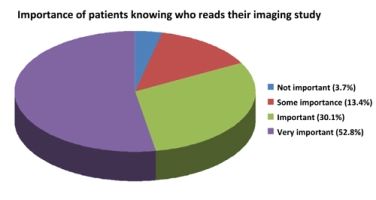Many Patients Aren’t Sure What Radiologists Do
CHICAGO - Many patients are confused about what radiologists do, but they want to know their image reader. It’s time to up the education and interaction.
CHICAGO - According to a new study, radiologists are pretty mysterious creatures.
But, according to Peter Miller, MD, they don’t have to be.
"The times of the invisible radiologist need a transition to the times of patient-centered radiology, with radiologists playing an active role in patient care and being more visible to their patients,” Miller said, who co-presented the study with his colleague, Richard Gunderman, MD, PhD, at RSNA 2012 this week.
“We sought to understand what patients know about radiologists,…to understand what patients want from their radiologists,…what patients want to know about their radiologists, and we wanted to answer the question, ‘Is it important to patients to know who is reading their radiology study?’” Miller explained, going on to identify the desire to improve radiologists’ value as physicians and the improvement of patient-centered care as additional study goals.
Researchers surveyed 307 hospital patients (with a 50/50 split between education levels of high-school or lower versus some college or higher). Of these respondents, 8.8 percent admitted to having no clue what radiologists do; 55.4 percent felt confused, and only 35.8 percent said they knew.
Only 53.5 percent believed radiologists are physicians, according to the study, and 32.7 percent believed radiologists to be technologists, instead.
The survey included questions about radiologist importance and patient transparency (i.e. doctor choice and medical-data access). In response, 52.8 percent said the identity of their image-reader was very important, 61.9 percent expressed an interest in getting copies of their radiology reports and 62.7 percent expressed interest in reviewing radiologists’ biographies and pictures online.

This study builds on another published in 2008 by the American College of Radiology, wherein one in two Americans didn’t know what a radiologist was.
Miller and Gunderman, professor and vice chair of radiology at the Indiana University School of Medicine, shared on-the-job anecdotes about the confusion.
But neither let flashes of humor distract from the issue of increasing the public’s understanding of radiology.
According to them, the best ways to fight the lack of information and improve patient-centered care is be to increase patient education about radiology, to make necessary changes to the system in terms of institutional-practice and department shifts and to pay more attention to patient knowledge disparities and needs. Miller then stressed the need to shift radiologists’ focus from gaining referring physician loyalty to patient loyalty.
“It turns out it’s much more fulfilling to be a doctor when you interact with patients face to face, when you feel that ‘I’m not just analyzing images, I’m actually caring for this human being,’” Gunderman said.
“Your day at the office, or your day at the hospital, or your career in a field like radiology ends up meaning a lot more to you when you feel that you’ve made that kind of difference in the care of your patients.”
Can MRI-Based AI Bolster Biopsy Decision-Making in PI-RADS 3 Cases?
December 9th 2024In patients with PI-RADS 3 lesion assessments, the combination of AI and prostate-specific antigen density (PSAD) level achieved a 78 percent sensitivity and 93 percent negative predictive value for clinically significant prostate cancer (csPCa), according to research presented at the Radiological Society of North American (RSNA) conference.
The Reading Room: Artificial Intelligence: What RSNA 2020 Offered, and What 2021 Could Bring
December 5th 2020Nina Kottler, M.D., chief medical officer of AI at Radiology Partners, discusses, during RSNA 2020, what new developments the annual meeting provided about these technologies, sessions to access, and what to expect in the coming year.
RSNA 2020: Addressing Healthcare Disparities and Access to Care
December 4th 2020Rich Heller, M.D., with Radiology Partners, and Lucy Spalluto, M.D., with Vanderbilt University School of Medicine, discuss the highlights of their RSNA 2020 session on health disparities, focusing on the underlying factors and challenges radiologists face to providing greater access to care.
New Interventional Radiology Research Shows Merits of Genicular Artery Embolization for Knee OA
December 3rd 2024In a cohort of over 160 patients with knee osteoarthritis (OA), including grade 4 in nearly half of the cases, genicular artery embolization led to an 87 percent improvement in the quality of life index, according to research presented at the recent RSNA conference.
Siemens Healthineers Debuts New Photon-Counting CT Systems at RSNA
December 2nd 2024Debuting at the Radiological Society of North American (RSNA) conference, the new photon-counting computed tomography (PPCT) scanners Naeotom Alpha.Pro and Naeotom Alpha.Prime reportedly combine rapid scan times with high-resolution precision.